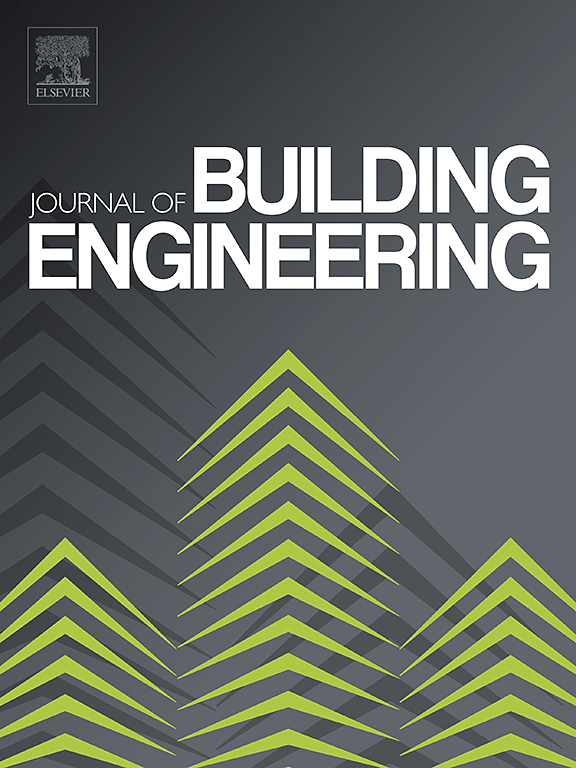自定心摩擦梁柱节点震害漂移极限预测与应用
IF 6.7
2区 工程技术
Q1 CONSTRUCTION & BUILDING TECHNOLOGY
引用次数: 0
摘要
近年来,自定心结构作为一种提高结构抗震性、最大限度减少残余位移和降低地震损失的有效策略,受到了广泛关注。然而,对自定心构件破坏标准的研究仍然有限,特别是在确定与各种破坏状态相对应的层间漂移比 (IDR) 方面。这一差距阻碍了基于性能的抗震设计的进步,导致缺乏基础数据来支持自定心系统的抗震评估。为解决这一问题,本研究以自定心摩擦梁柱连接(SCFJ)为主要研究对象。首先,定义了 SCFJ 的四种不同损坏状态,并开发和验证了有限元 (FE) 模型。通过敏感性分析,确定了影响 SCFJ 抗震性能的关键设计参数。根据典型的工程实践,共构建了 432 个具有不同截面尺寸和设计参数的有限元模型,从而建立了 SCFJ 的综合震害数据库。随后,通过统计分析确定了每种破坏状态的 IDR 临界值,并相应地拟合了脆性曲线。然后将这些脆性曲线用于评估两个六层框架结构的破坏和地震损失。结果表明,SCFJ 的破坏主要集中在缩小部分,与轻微、轻度、中度和严重破坏相对应的平均 IDR 分别为 0.52 %、1.07 %、1.74 % 和 3.48 %。在考虑的最大地震下,SCFJ 主要表现为轻微至轻度破坏,相关地震损失为 30,500 元人民币,与普通钢筋混凝土接头(ORCJ)相比减少了 41.6%。这些研究结果表明,与 ORCJs 相比,SCFJs 的损坏程度明显降低,地震损失也更小,为未来的抗震性能和抗震性评估提供了理论依据。本文章由计算机程序翻译,如有差异,请以英文原文为准。
Seismic damage drift limits of self-centering friction beam-column joints: Prediction and application
In recent years, self-centering structures have garnered significant attention as an effective strategy to enhance structural resilience, minimize residual displacements, and reduce seismic losses. However, research on the damage criteria for self-centering components remains limited-particularly in determining the inter-story drift ratios (IDRs) corresponding to various damage states. This gap has hindered advancements in performance-based seismic design and resulted in a lack of foundational data to support resilience assessments for self-centering systems. To address this issue, this study focuses on the self-centering friction beam-column joint (SCFJ) as the primary research subject. First, four distinct damage states for SCFJs are defined, and a finite element (FE) model is developed and validated. Sensitivity analyses are performed to identify key design parameters affecting the seismic performance of SCFJs. Based on typical engineering practices, a total of 432 FE models with varying section dimensions and design parameters are constructed, establishing a comprehensive seismic damage database for SCFJs. Subsequently, statistical analysis is used to determine the IDR thresholds for each damage state, and fragility curves are fitted accordingly. These fragility curves are then applied to evaluate damage and seismic losses in two six-story frame structures. Results indicate that damage in SCFJs is primarily concentrated in the reduced section, and the mean IDRs corresponding to slight, mild, moderate, and severe damage are 0.52 %, 1.07 %, 1.74 %, and 3.48 %, respectively. Under the maximum considered earthquake, SCFJs predominantly exhibit slight to mild damage, with associated seismic losses amounting to 30,500 CNY-representing a 41.6 % reduction compared to ordinary reinforced concrete joints (ORCJs). These findings demonstrate that SCFJs exhibit significantly reduced damage and lower seismic losses than ORCJs, providing a theoretical basis for future seismic performance and resilience evaluations.
求助全文
通过发布文献求助,成功后即可免费获取论文全文。
去求助
来源期刊

Journal of building engineering
Engineering-Civil and Structural Engineering
CiteScore
10.00
自引率
12.50%
发文量
1901
审稿时长
35 days
期刊介绍:
The Journal of Building Engineering is an interdisciplinary journal that covers all aspects of science and technology concerned with the whole life cycle of the built environment; from the design phase through to construction, operation, performance, maintenance and its deterioration.
 求助内容:
求助内容: 应助结果提醒方式:
应助结果提醒方式:


